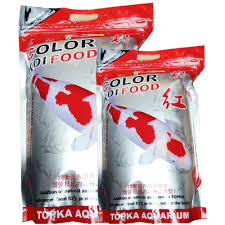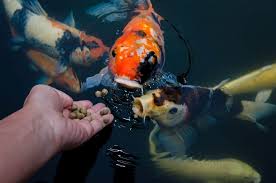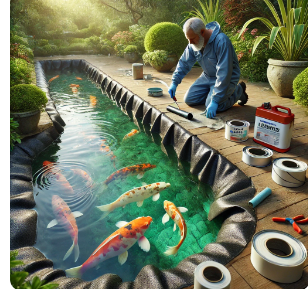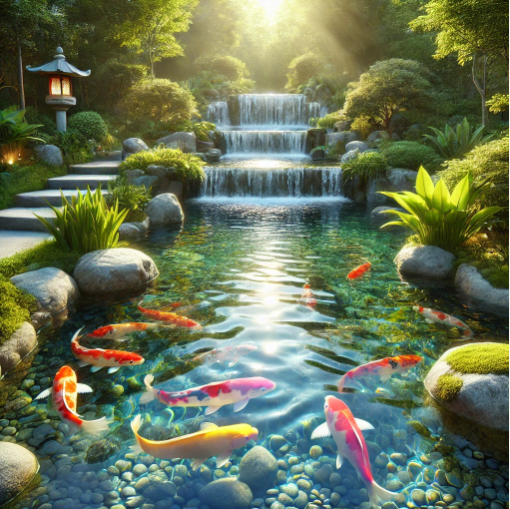Koi fish are beautiful, long-lived, and vibrant, but their health and color depend largely on what they eat. Feeding your koi the right diet ensures strong growth, bright colors, and a long lifespan. But with so many koi foods available, how do you choose the best one?
This guide will help you understand the best food for koi fish, what nutrients they need, how often to feed them, and seasonal feeding tips to keep them thriving.
What Do Koi Fish Eat in the Wild?
Koi fish are omnivores, meaning they eat both plant and animal-based foods. In their natural habitat, they consume:
✔ Insects and larvae
✔ Small crustaceans
✔ Algae and aquatic plants
✔ Seeds and fruit that fall into the water
In captivity, you need to mimic their natural diet to keep them healthy and active.
What Nutrients Do Koi Fish Need?
A balanced diet for koi fish includes:
1. Protein (30-40%) – For Growth & Muscle Development
Protein is crucial for koi, especially young fish that are still growing. The best protein sources include:
✔ Fish meal
✔ Shrimp meal
✔ Spirulina
✔ Soybean meal
🔹 Pro Tip: High-protein food is best during warm months when koi have a faster metabolism.
2. Carbohydrates (10-20%) – For Energy
Koi need some carbs, but too much can cause digestive issues. Safe sources of carbs include:
✔ Wheat germ
✔ Rice bran
✔ Corn
🔹 Avoid low-quality fillers like excessive corn or wheat, which can cause bloating.
3. Fats (5-10%) – For Energy & Absorption of Nutrients
Healthy fats keep koi active and energetic while helping them absorb vitamins. Good fat sources include:
✔ Fish oil
✔ Krill oil
✔ Linseed oil
🔹 Pro Tip: During winter, koi need lower fat intake as their metabolism slows down.
4. Vitamins & Minerals – For a Strong Immune System
Koi require essential vitamins and minerals for bone strength, disease resistance, and color enhancement.
✔ Vitamin C – Boosts the immune system
✔ Vitamin D – Strengthens bones
✔ Vitamin E – Supports skin and scales
✔ Calcium – Essential for bone growth
High-quality koi food brands include these vitamins to prevent deficiencies.
5. Color-Enhancing Ingredients – For Brighter Koi Colors

Want your koi to have deep reds, bright oranges, and pure whites? Feed them food with natural color enhancers like:
✔ Spirulina – Enhances reds and oranges
✔ Carotenoids (shrimp meal, krill) – Boosts yellow and red pigments
✔ Wheat germ – Maintains skin quality
🔹 Pro Tip: Feed color-enhancing food for 6-8 weeks before a koi competition for maximum brightness.
Best Types of Koi Fish Food

There are three main types of koi food, each serving a specific purpose.
1. Floating Pellets – Best for Monitoring Feeding
✔ Encourages koi to come to the surface
✔ Allows you to observe their health
✔ Helps prevent overfeeding
🔹 Recommended for: Hobbyists who want to watch their koi feed.
2. Sinking Pellets – Best for Shy or Bottom-Feeding Koi
✔ Ideal for new or timid koi
✔ Reduces aggression at the surface
✔ Mimics natural feeding behavior
🔹 Recommended for: Older or more dominant koi that prefer feeding lower in the pond.
3. Treats & Supplements – For Variety & Nutrition Boost
Koi love treats, which also provide extra nutrients. Some healthy treats include:
✔ Live worms – Great protein boost
✔ Frozen shrimp – Enhances colors
✔ Leafy greens (lettuce, spinach) – Helps digestion
✔ Fruits (oranges, watermelon, bananas) – Adds vitamins
🔹 Pro Tip: Avoid giving koi bread, as it lacks nutrients and can cause bloating.
Best Koi Food Brands (Recommended by Experts)
Not all koi food is created equal! Here are some top-rated koi food brands for health, growth, and color enhancement:
1️⃣ Hikari Saki Growth – Best for rapid growth
2️⃣ Dainichi Koi Premium – Rich in probiotics for digestion
3️⃣ TetraPond Koi Vibrance – Budget-friendly option with color enhancers
4️⃣ Blue Ridge Koi Food – High-quality protein formula
5️⃣ Omega One Koi Pellets – Contains natural seafood for color boost
🔹 Pro Tip: Rotate different koi foods to give them a balanced diet.
How Often & How Much Should You Feed Koi?
Feeding koi the right amount at the right time prevents waste buildup, ammonia spikes, and overfeeding problems.
Feeding Frequency by Temperature:
🌡 Above 70°F (21°C) – 2-4 times daily (high-protein food)
🌡 60-70°F (15-21°C) – Once or twice daily
🌡 50-60°F (10-15°C) – Once every 1-2 days (low-protein food)
🌡 Below 50°F (10°C) – Stop feeding (koi’s digestion slows)
How much to feed?
✔ Only feed what they can eat in 3-5 minutes.
✔ Remove any uneaten food to prevent water contamination.
Seasonal Feeding Tips for Koi Fish
Koi have different nutritional needs in each season. Adjust their diet accordingly:
🍃 Spring – Start feeding lightly as water warms up. Use wheat germ for easy digestion.
☀ Summer – Feed high-protein food for growth & color enhancement.
🍂 Fall – Reduce protein intake and switch to easily digestible food.
❄ Winter – Stop feeding below 50°F (10°C). Their metabolism slows, and they don’t need food.
🔹 Pro Tip: Use a pond thermometer to monitor temperature and adjust feeding accordingly.
Common Feeding Mistakes to Avoid
🚫 Overfeeding – Leads to pond pollution and ammonia spikes.
🚫 Using expired food – Loses nutrients and may contain mold.
🚫 Feeding too much in cold weather – Koi can’t digest properly.
🚫 Skipping variety – A mix of pellets, treats, and natural foods keeps koi healthy and happy.
Final Thoughts
Feeding koi fish the right diet is key to their health, growth, and vibrant colors. Choosing high-quality food, feeding in moderation, and adjusting for the seasons will help your koi live a long and beautiful life.
Top Takeaways:
✔ Feed high-protein food in warm months for growth.
✔ Use color-enhancing ingredients for vibrant koi.
✔ Avoid cheap foods with fillers (corn, wheat).
✔ Adjust feeding based on water temperature.
By following this nutrition guide, your koi will thrive, stay healthy, and showcase their stunning colors for years to come!
📌 What’s your favorite koi food brand? Share your experience in the comments! 🐠💦




